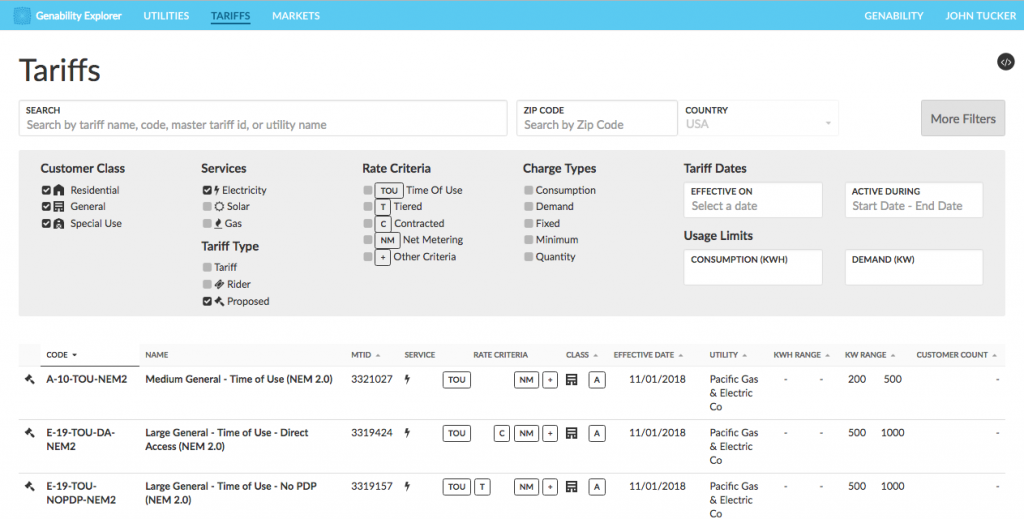Products
Proposed Tariffs included in Genability database
By John Tucker
| Reading time 4 minutes
Our Proposed Tariffs feature allows you to use our complete set of tools to calculate the costs and savings of tariffs that are not yet published and live.

Genability is pleased to announce the immediate availability of both a new product feature and a new set of tariff data.
What are Proposed Tariffs?
This year the California Public Utility Commission approved General Rate Cases for both Pacific Gas & Electric and Southern California Edison. These rates won’t go into effect until 2019, but when they do the Time of Use periods will change quite significantly for the majority of commercial and industrial customers. Our new energy companies need to assess the impact of these change right now to be ready for the transition. California is not the first market, and won’t be the last, to consider and implement sizable structural changes to tariffs. To address this need, today we are making available Proposed Tariffs.
Our Proposed Tariffs feature allows you to use our complete set of tools to calculate the costs and savings of tariffs that are not yet published and live, such as those mentioned above. You can do all the same things with proposed tariffs as you can with published ones. We’re excited to say that Proposed Tariffs are available now as an optional subscription for any enterprise customer.
What Proposed Tariffs do we Model?
Our first Propose Tariffs are the time of use commercial tariffs for both PG&E (A-10, E-19, E-20) and SCE (TOU-GS-1, TOU-GS-2, TOU-GS-3, TOU-8). In the future, when tariffs in major markets are redesigned Genability will model them as Proposed Tariffs. In addition to being in a major market, the tariff redesign must be approved by the local utility commission before we model the new tariff.
A redesigned tariff might have new charge types introduced (e.g. a new ratchet demand charge), charge types removed, new seasons or time of use periods and increasingly new rules for compensating solar customers for electricity provided to the grid. All of these scenarios can trigger a proposed tariff. A simple rate increase or decrease rarely warrants a proposed tariff.
How do I use Proposed Tariffs?
You can retrieve Proposed Tariffs both in Explorer and all of our APIs where currently access other tariffs . You do not need to call new APIs or log into new web applications. There is one key difference, however. In both Explorer and our APIs you have to explicitly ask for Proposed Tariffs to be included. We’ve made it an explicit opt-in request parameter to make sure you don’t accidently use Proposed Tariffs when you don’t want or expect to.
In the Tariff API, you can request Proposed Tariffs by including the value PROPOSED in the parameter tariffTypes. This allows you to just get proposed tariff, or to have them included with other tariffs too. Here’s a sample call for PG&E:
GET /rest/public/tariffs?lseId=734&tariffTypes=PROPOSED
This will provide you with the Master Tariff Id of the PROPOSED tariff which you can then use as you would any other tariff in the Calculate API, Account API or other Tariff APIs. Once you have the Master Tariff ID, you can use it like any other tariff to run calculations, set on an account and any other way you use a current tariffs in our APIs
What is the Lifecycle of a Proposed Tariff?
Proposed Tariffs exist for the period between when the utility commission has approved the redesign and the tariff becomes effective. As such it has its own, new Master Tariff Id that is not connected directly to either the preceding tariff or the tariff that becomes effective. Instead, you can use the tariff properties precedingMasterTariffId and succeedingMasterTariffId to determine the tariff it replaces (preceding) and the tariff it becomes (succeeding).
When the Proposed Tariff becomes effective, the Proposed Tariff will be marked as Closed and end-dated. You can still run calculations against the tariff, but it Proposed Tariff will no longer appear in standard Tariff requests.
There are several ways that the utility can introduce a redesigned tariff. In the table below, we outline how we handle the different methods of transitioning to new tariff structures.
| Scenario | Redesigned Tariff | Legacy Tariff |
|---|---|---|
| Utility grandfathers existing customers to legacy tariff | Gets a new Master Tariff Id | Keeps the original Master Tariff Id and is “Closed” |
| Utility switches existing customer to redesigned tariff, some customers can remain on legacy tariff | Inherits the legacy Master Tariff Id | Gets a new Master Tariff Id that is “Closed” and is labelled “Granfathered” |
| Utility switches all existing customers to redesigned tariff, no exceptions | Inherits the legacy Master Tariff Id | There is no legacy tariff. |
Can I Use Proposed Tariffs?
Proposed Tariffs are made available to your organization on an application basis. This allows you to enable Proposed Tariffs for some of your applications (e.g. your analyst team) while excluding Proposed Tariffs for other (e.g. your production integration).
Proposed Tariffs is an optional subscription for Genability’s enterprise customers. If you think your team would benefit from Proposed Tariffs, contact your company’s account owner to confirm or arrange access.
Also in Products
Genability Adds Support for PVWatts Version 6
By Ruben Garcia | Nov 1, 2018
Explorer Web App for Energy Professionals
By Jason Riley | Aug 1, 2018
Estimating Energy Usage from Customer’s Bill Amount
By Jenny Trinh | Dec 5, 2017
Run Down of Genability Developer Website Updates
By Charity Vargas | Nov 10, 2017

